
Red Star RS1/4 Lavochkin LaGG-3, Red Star Model Kits Ltd,
distributed by CMS Marketing International, 1983, four kits pack
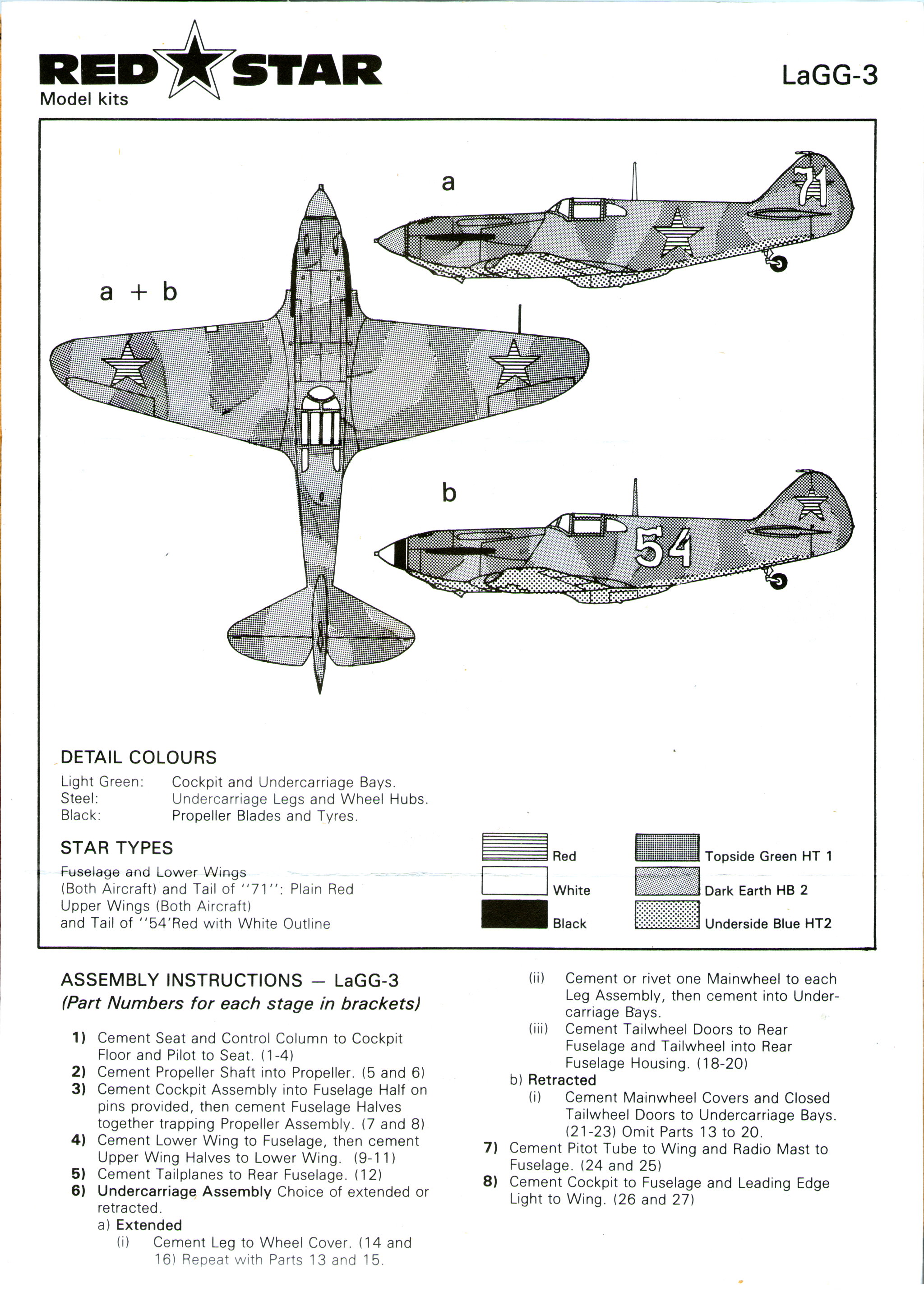

Red Star
Red Star Model Kits Ltd., 16 Whitecroft Road, Beckenham, Kent, England BR3 3AG
Period: 1983 to date
Of the 169 Frog moulds completed from 1955 to 1977, only six are believed still to remain in Great Britain. Two of these (the Dennis Ambulance and Firefly Dinghy moulds) are with Hornby Hobbies and the other four with Red Star.
These four are the so-called "Russian" moulds completed by Rovex specifically for use in the USSR, but in the end never sent there. After several attempts to sell them to established kit producers, the Novo receivers finally found a buyer in the Red Star company; a small firm with a rather unusual story behind it.
The story of Red Star goes back to 1982 when Jim Chapman — the subsequent founder of Red Star — took a holiday in the Soviet Union. Before departure he made enquiries to discover where he might be able to purchase kits for his own use. Before he left he heard from the relevant Soviet authority, who also advised him that the possibility of importing a range of ex-Frog kits to the West was under active consideration.
On his return home, he contacted the Soviet import agency with a view to offer advice on the proposed import project. The initial advice took the form of a review of the alternative kits available. This led to further meetings where it became obvious that the agents had rather vague ideas on the choice of suitable kit subjects and not much practical knowledge on matters such as packaging and decals (at one point a peel-off/stick-on type of markings was seriously considered, and some test sheets on white backing paper were printed!). The question of finding a suitable distributor was also pending, but in the end the agents choose Capital Models Supply (CMS). See Novoexport for more details of this operation.
During his enquiries for the CMS import project, Jim discovered the existence of the four moulds later acquired by Red Star. Initially he was asked to cost a scheme to acquire and market these moulds as an ancillary project to the main import scheme. Although his report showed this to be feasible, the Soviets did not wish to proceed until the main scheme was well under way.
As by this time he had invested a considerable amount of effort in the project, Jim Chapman was however reluctant to see the moulds disappear to Eastern Europe. He therefore put forward a proposal to a number of people to see if a consortium could be put together to handle the moulds without Soviet involvement. After a number of false starts and changes in the expected participants, a company was arranged to handle the scheme. This was Glenprime Ltd., but the name was soon changed to Red Star Model Kits Ltd.
By July 1983 they were ready to go into production and on October 31st CMS - who had been appointed sole distributor - took delivery of the first 3,000 of the 7.000 four-kit sets ordered by them. In the event, only about 2.000 of these were sold as sets, the balance being repacked singly in polythene bags with header cards, mainly to meet US orders received by CMS in the spring of 1984. Most sets had a red and white label, but a few of the last ones sold after October 1984 had this replaced by a photocopy.
After CMS went into receivership in August 1984, attempts to get the intended backers of CMS' Soviet import scheme to continue were unsuccessful. Jim then put forward various schemes whereby the Soviets could act as their own distributors for at least a limited scheme. When none of these proposals had elicited much of a response by March 1985, Red Star offered to run such a project on behalf of the Soviets and - to ensure that there was no financial risk to the Soviets — offered to surrender Red Star's moulds as payment. This scheme was initially accepted but then the Soviets changed their mind and progress stopped. Other proposals covered an exchange of moulds to enable production to take place in England but this was also turned down.
Finally a simple offer to purchase kits for cash was put forward. This was accepted in December 1985 and an initial range of nine kits (all from the DFI factory) was agreed upon. Of these, the Maryland was subsequently dropped as a small mould defect was found. It was hoped that a further sixteen types (including the Sea Venom and Whitley) would follow later. In addition, the Soviets offered delivery of 1,000 Shackletons from existing stocks.
But nothing has happened since and Red Star are still waiting for their kits. Apparently the Soviets developed cold feet at the last moment and the future of the deal is somewhat uncertain. It is possible that the recent large exports to Eastern bloc countries (to pay for food imports to the nuclear stricken Ukraine) has taken up much of the available capacity. There are two hopeful signs, however. The first is the Soviets' undeniable interest in acquiring the Red Star moulds. The second is the recent changes in Soviet hierarchy. Fresh approaches have recently been made so there is still hope. . .
In anticipation of the first Soviet deliveries, Red Star commissioned new artwork for the Skua, Vengeance and Ventura. In addition, new decals were designed for the Skua and Ventura. This work was done by Dick Ward of Modeldecal, who also did the previous Red Star decals. Meanwhile, production of the first four kits was (temporarily) suspended in March 1987. By then, total production was as follows: MiG-3 12,500, LaGG-3 11,500, Anatra 9,500 and Yak-3 8,500 pieces. Mould problems have necessitated a few small adjustments, as can be seen when comparing with samples produced by Rovex. A small batch of review samples was made in translucent white and bulk production in medium grey.
FROG model aircraft 1932-1976, R. Lines, L. Hellstrom"
|

Red Star RS102 Lavochkin LaGG-3, Red Star Model Kits Ltd, 1984
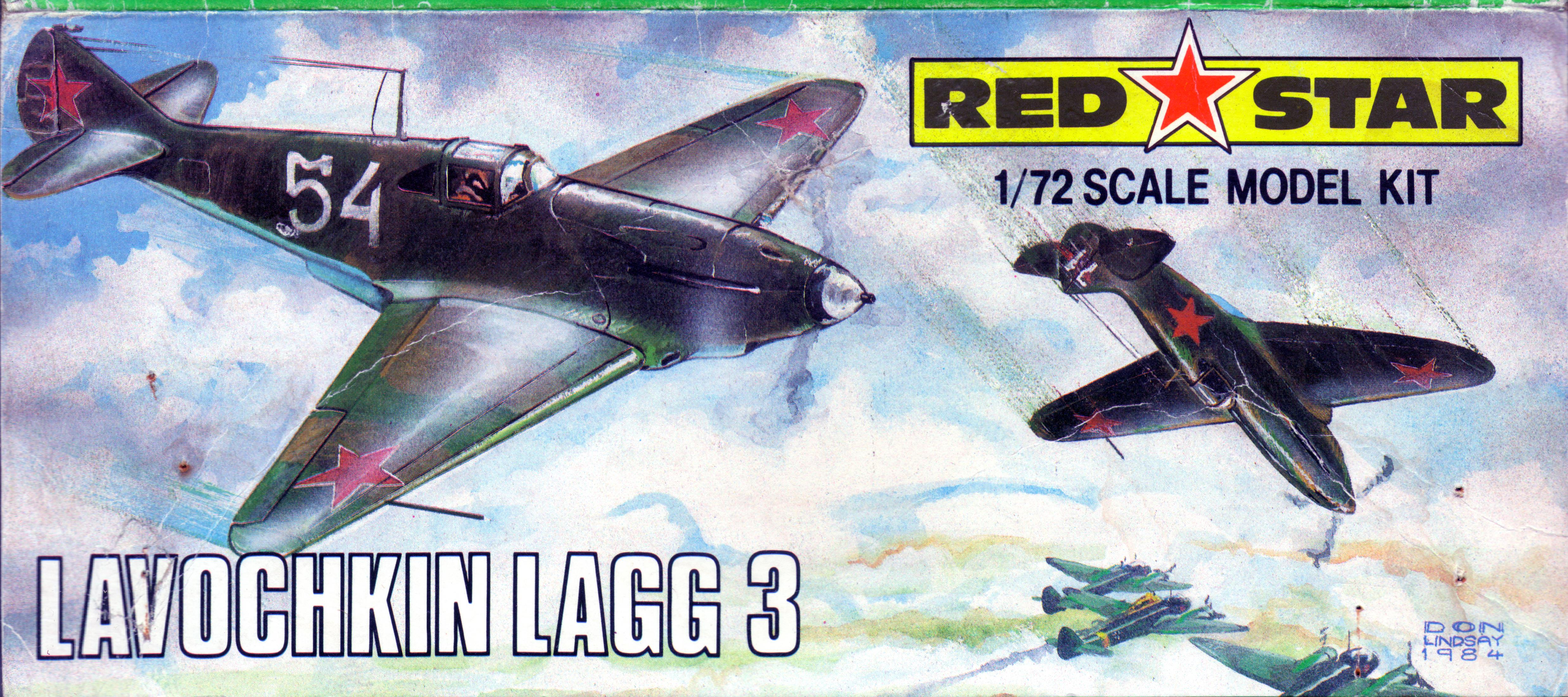

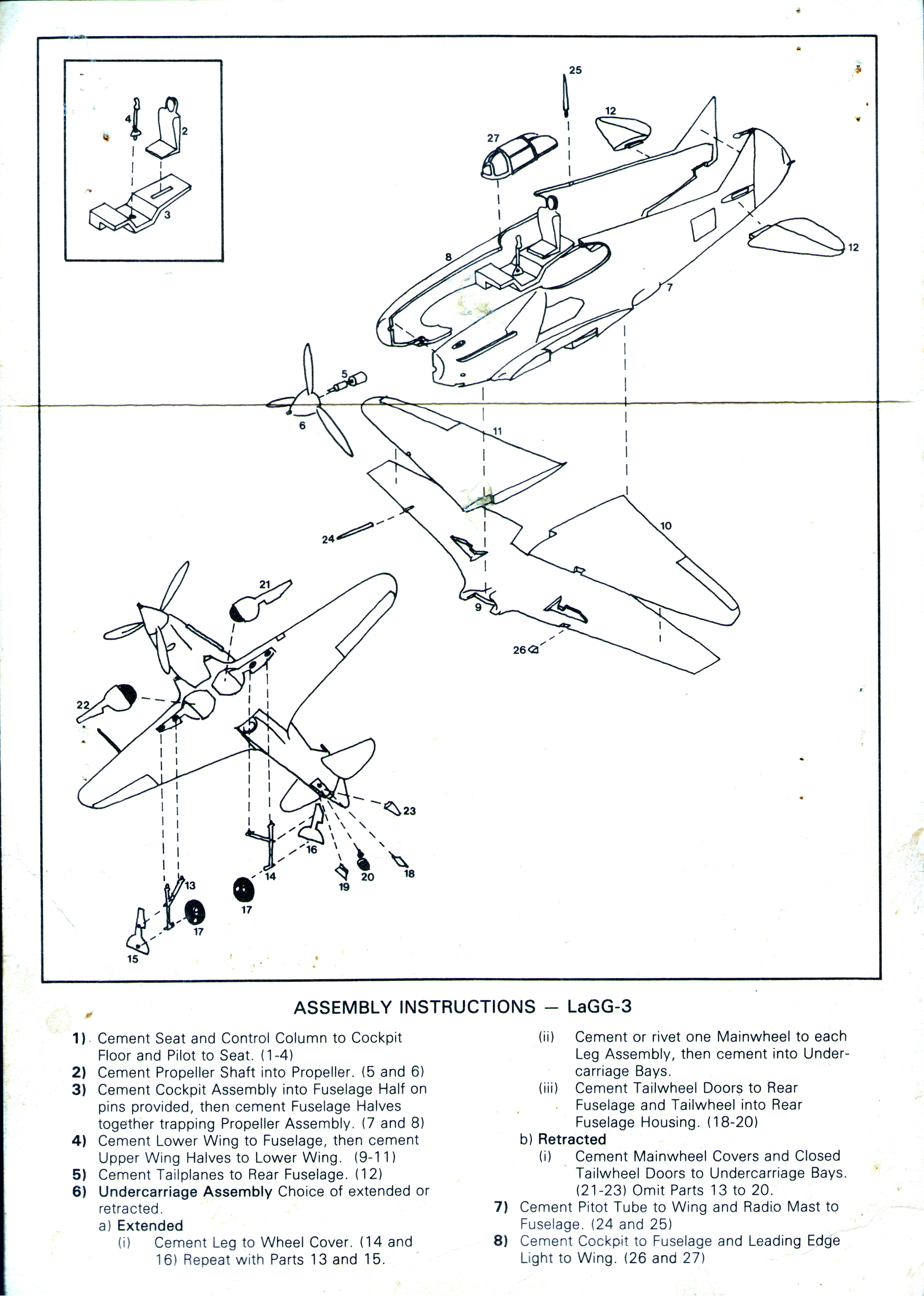
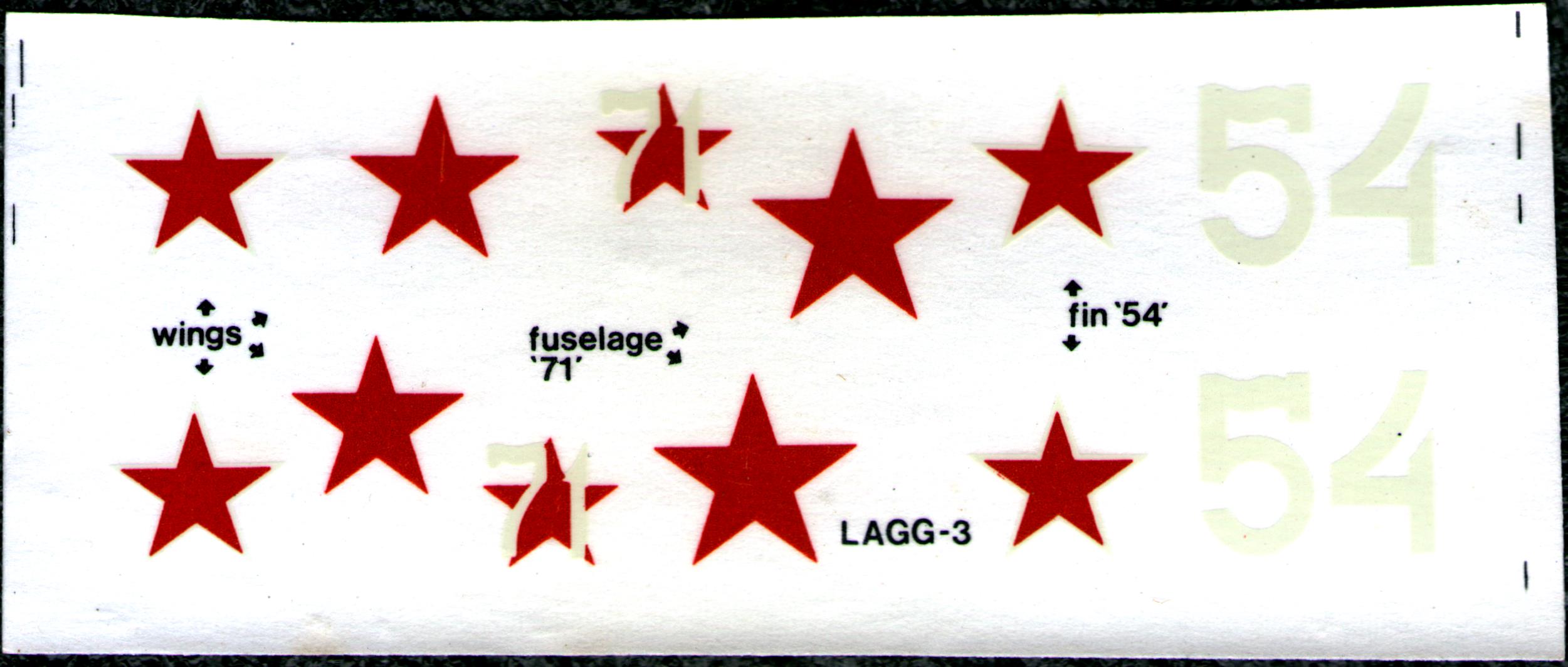
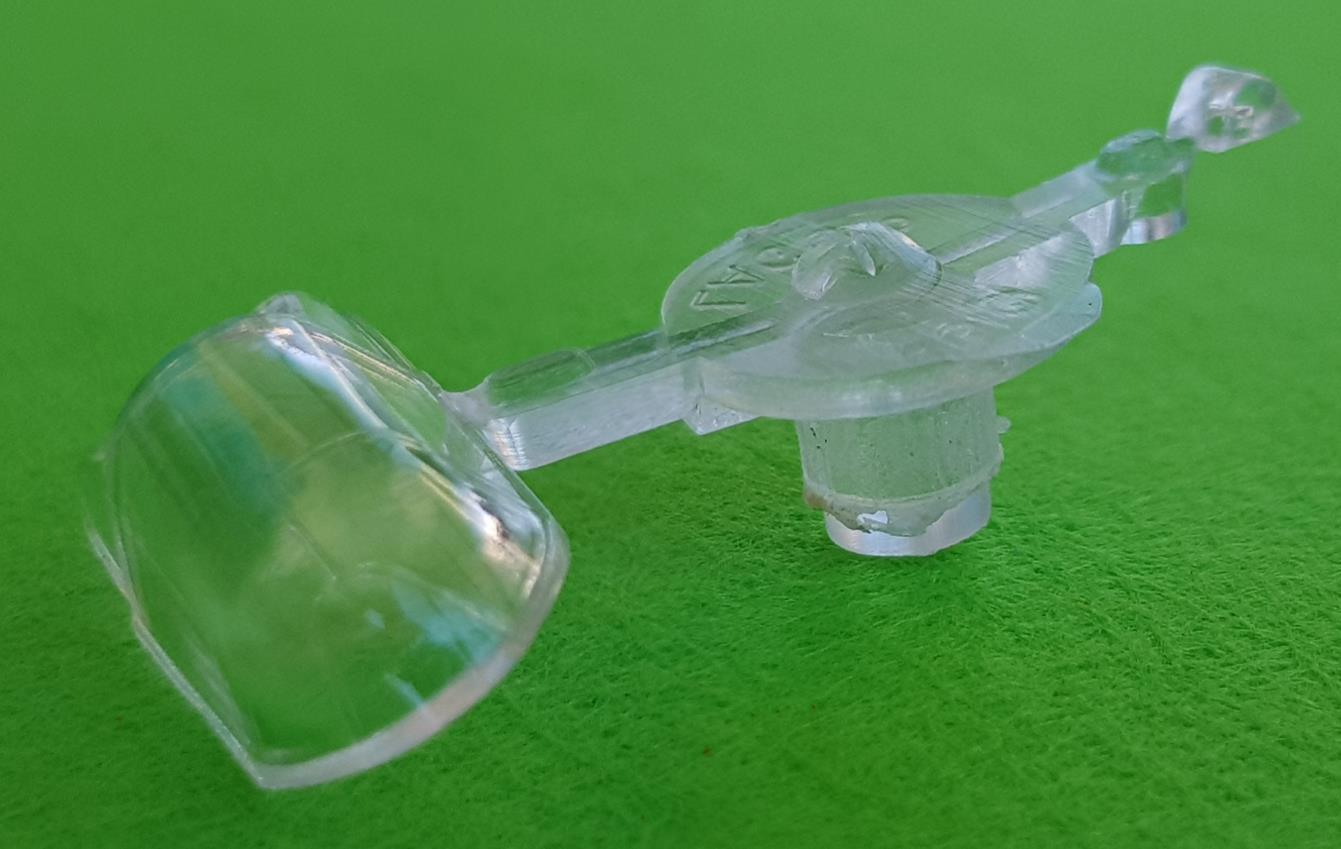
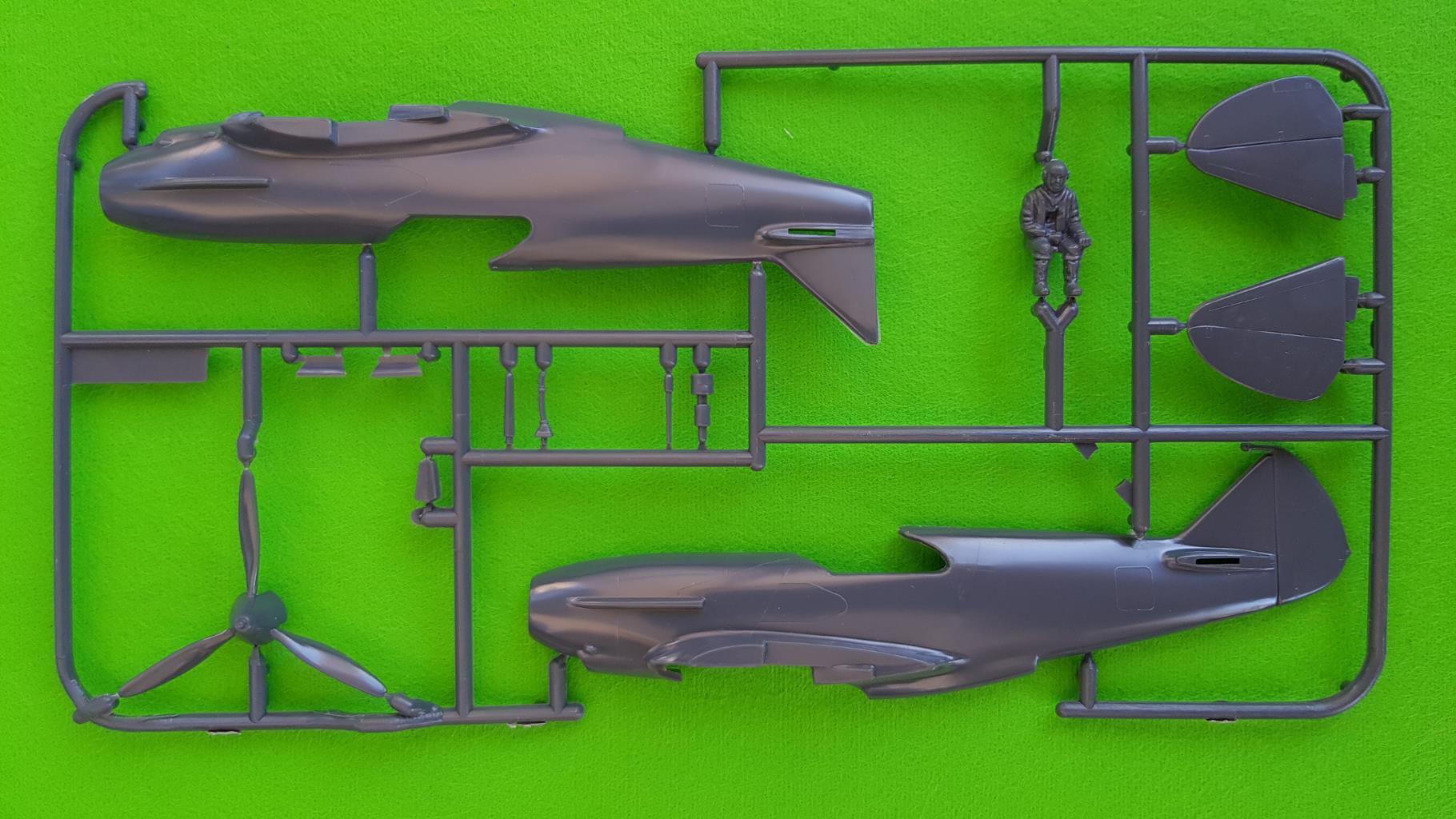
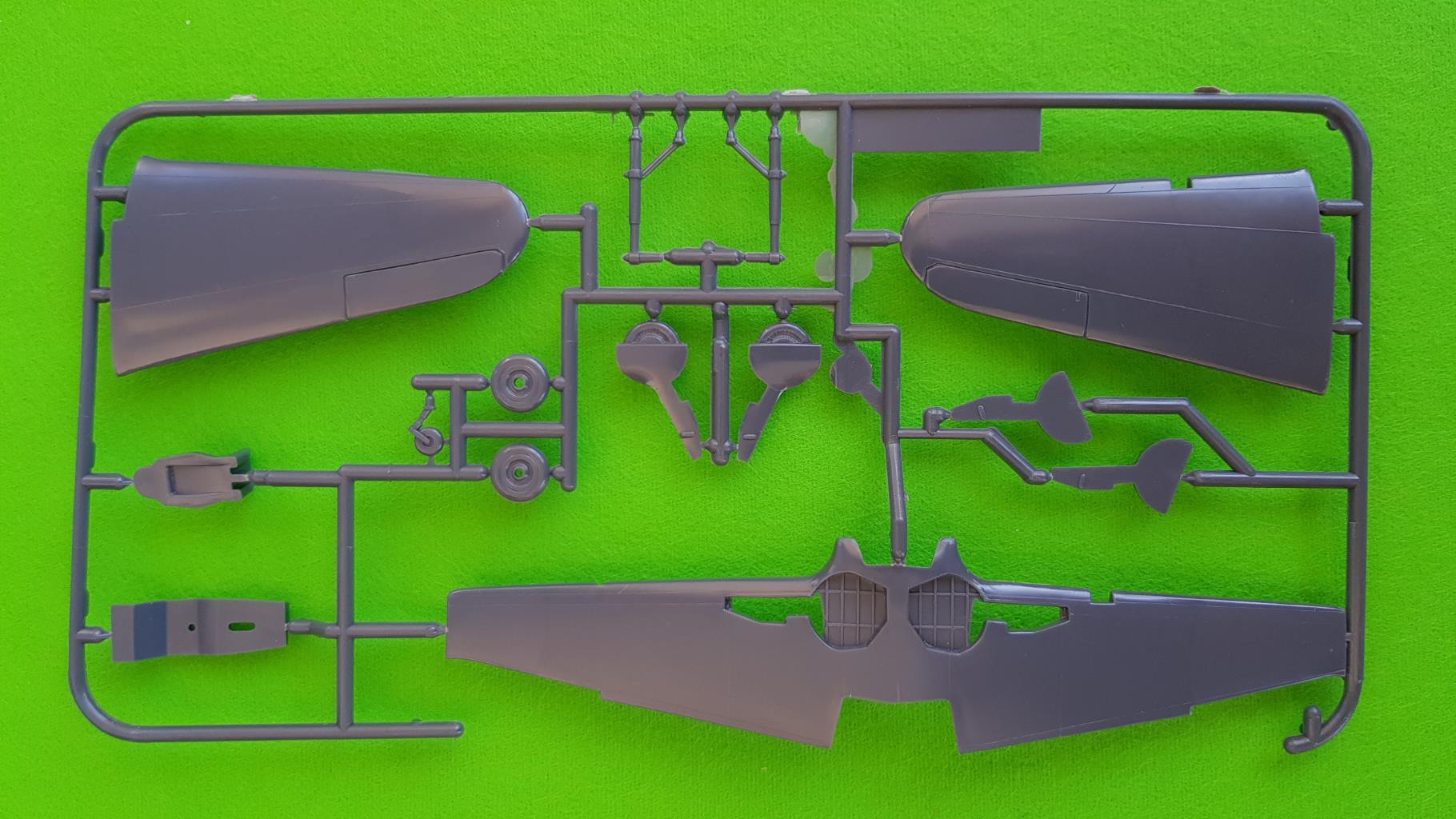

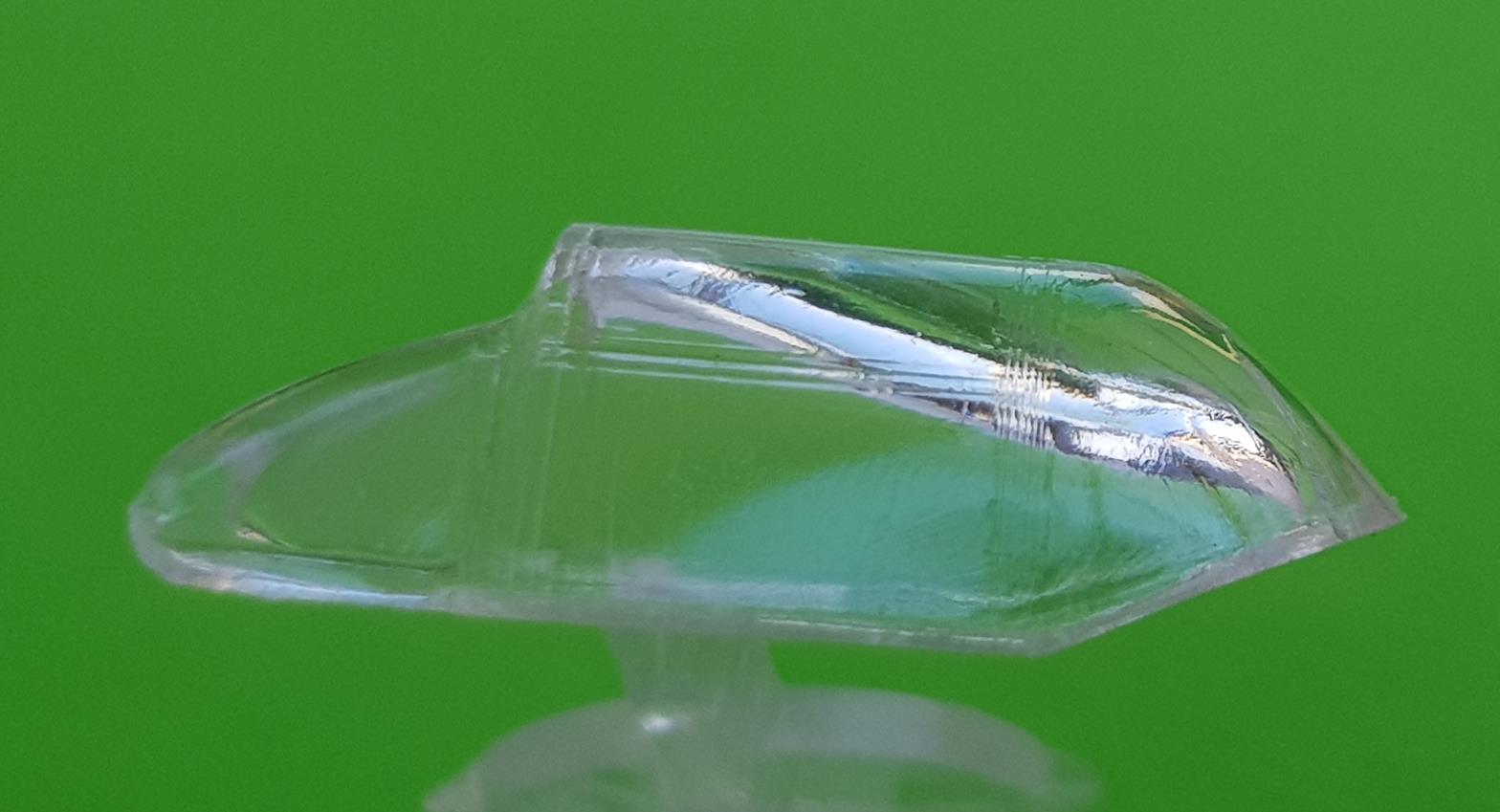
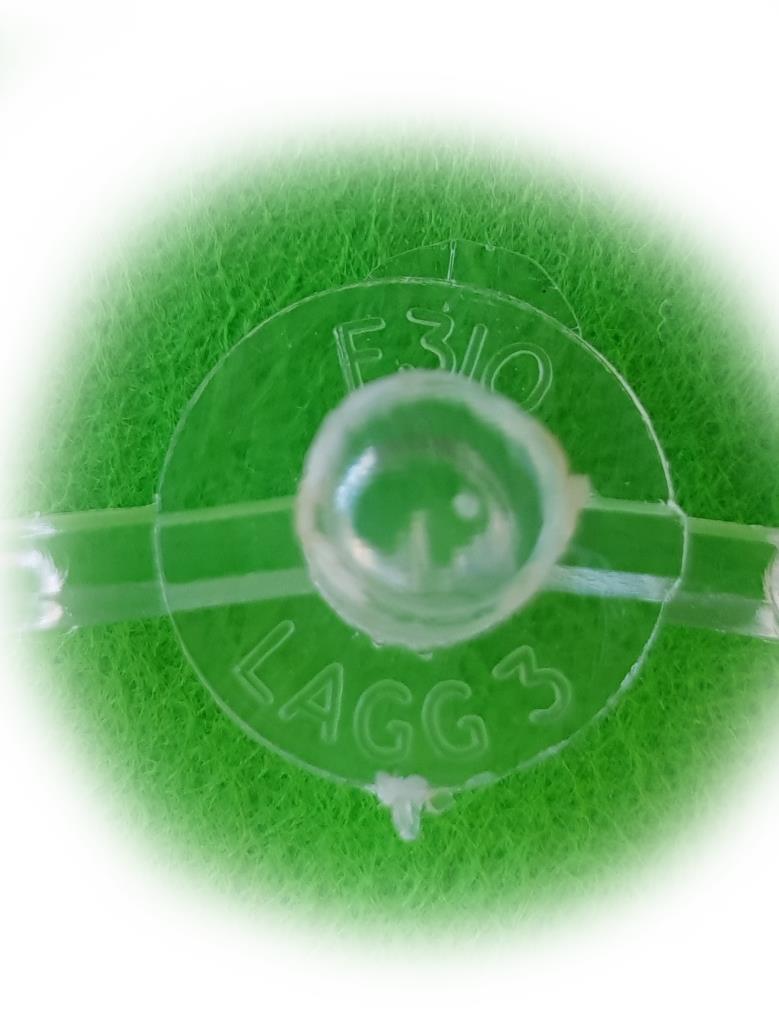
Russian stars and a cockade.
A newcomer to the realms of kit production is CMS Marketing International (42 Anerley Hill, London SE19) which is issuing a range of kits under the appropriate appellation of Red Star, the first group of four comprising three WWII Soviet fighters and a WWI reconnaissance aircraft. The ancestry of these kits, if a little tenuous, is interesting in that it can be traced back to the oldest kit maker in the plastic business, Frog, whose moulds, after the company was liquidated, mostly found their way to the Soviet Union to be restored to production with Novo, the arrangement being that a quantity of each kit would be exported for sale in the UK.
In the mid-'seventies, when this arrangement was being made, the Soviet negotiators were conscious of the dearth of Russian aircraft among those represented by the Frog moulds and it was agreed that new moulds would be prepared in the UK of types of their choice to introduce a Soviet admixture. Coincidentally, Rovex Limited's master drawings for the new moulds were corrected from material from AIR International's files. Distribution in the UK of the imported Novo kits was in the hands of the Dunbee-Combex-Marx toy group, which, eventually, itself went into liquidation, and thus the Novo/Frog kits were no more. Insofar as the new moulds for the Russian types were concerned, however, it would seem that these never got as far as the Soviet Union as, happily, they have now been released in the UK.
As already stated, three of the kits depict WWII fighters, these being the MiG-3, LaGG-3 and Yak-3, and the fourth represents the WWI Anatra-DS Anasali. The standard of the kits may be summarised as typically Frog, which will be sufficiently descriptive for most modellers with memories of that sorely missed range of kits. For others we would say that they are accurate, quite well detailed and easily assembled kits, without frills, but providing the potential to produce excellent replicas of the aircraft that they represent with some effort on the part of the modeller in adding refinements. The mouldings are clean and the surface detailing adequate without being overdone for the scale. Some refinements are there, such as engraved detail in the wheel wells of the MiG-3 and LaGG-3, and in the cockpit interiors there is sufficient detail, especially in that of the Anatra.
The plastic used for these kits is of a high grade in a medium grey shade, the fighters having between 27 and 30 component parts each and the Anatra biplane 47 parts. The last-named is a fascinating oddity, even among WWI aircraft, although it saw quite extensive service both in pre- and post-revolutionary Russia, and its two-bay wing cellule with individual pairs of interplane struts makes for more complex construction. However, ingenious planning of the kit helps considerably, notably with the fuselage which has a separate one-piece top deck incorporating the tailplane.
The kits are individually packaged in polythene bags with full-colour card backings which include three-view drawings. Top quality dccals are provided in each case, with, for the Yak-3, the insignia of the Normandie-Niemen unit. All markings are well chosen, and for the Anatra-DS they represent pre-revolutionary cockades. At present, these kits are only obtainable direct from CMS Marketing International, but we understand that distributors will be appointed in due course. The WWII fighters are each priced at £2-35 and the Anatra-DS at £2-85, plus postage in each case.
AIR INTERNATIONAL/JUNE 1984
Comment and criticism
When reviewing the four Red Star kits in this column (June issue), we inadvertently inferred that these kits are manufactured by CMS Marketing International. We would like to make it plain that the kits are, in fact, produced by Red Star Model Kits Limited, an entirely separate company to CMS Marketing International which is the sole distributor.
F.J.Henderson
AIR INTERNATIONAL/AUGUST 1984
FSM Workbench Reviews
Kit: No. F310, Lavochkin Lagg-3 Scale: 1/72
Manufacturer: Red Star Model Kits,
distributed by CMS Marketing International, 42
Anerley Hill, London SE19, England
Price: $5.98
MODELS OF RUSSIAN aircraft come few and far between, so I was glad to see the new Red Star kits of the Lagg-3, MiG-3, Yak-3, and Anatra. These are some of the last molds Frog made before it went under. The molds first went to Novo, the Russian-owned concern that purchased many of the Frog molds, and ended up back in England where the Red Star kits are now being produced.
The Lagg-3 kit is typical of Frog's last releases; what little detail is included is nicely done. The kit's 29 parts have fine raised panel lines and recessed control hinge lines. Clear parts (canopy and landing light) are thick and a bit too large to fit well. The nose gun breach blisters are missing but clearly visible in photos, and the gun barrels were not cleanly molded. The well-printed decals include markings for two aircraft. There are no construction drawings, but a top view and two side views are included on the instruction sheet. Although the kit is simple and the instructions are clearly written, I would have liked construction diagrams and information about the aircraft.
The kit went together nicely with little filling required. There was a little overlap at the wing leading edge and the horizontal stabilizers were thicker than the stub roots on the fuselage. The propeller spinner had sinkholes that I found difficult to correct, so I substituted Heller's P-39 prop.
There appears to be an outline problem to the wing planform according to the drawings in Air International, Vol. 20, No. 1; there should be more sweep back to the leading edges. Otherwise, the model looks good. I took eight hours to complete the model. It can easily be handled by beginners, and it's a welcome addition to World War Two aircraft collections.
Al Jones
FineScale Modeller Vol 02 No07 1984 Nov-Dec"
|




